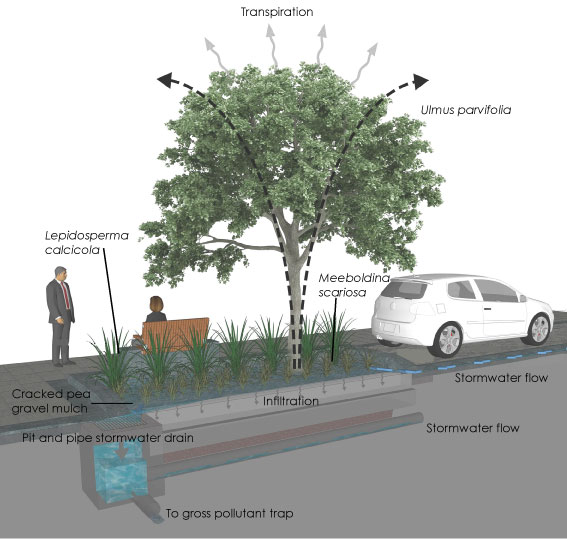
Project Details
A network of raingardens linking Perth's city centre with Northbridge simultaneously manages stormwater while providing shade and protection against the heat.
WSUD Category: Tree pits
| Criteria | Information |
|---|---|
| Development Type: | Residential |
| Function/Driver: | Amenity |
| Government Area: | City of Perth |
| Site Context: | Shallow groundwater |
| Year Completed: | 2015 |
The Perth City Link (PCL) project’s core vision is to reconnect Perth’s city centre with Northbridge. It will become the new commercial core to the city with water sensitive stormwater management solutions integrated into the streets and open spaces. The site straddles the recently sunk railway line into Perth Central Train Station between Wellington Street and Roe Street with the Perth Arena at the western end and William Street Overpass at the eastern end.
As part of the design of the streetscape, a water sensitive urban design strategy was developed that includes a network of raingardens integrated with street parking. These raingardens provide retention, filtration, litter management and bio-remediation outcomes and integration with street furniture and lighting.
The raingardens are designed to fit into the cross sectional parking dimension between road crossing points. They are located to accommodate alfresco dining and retail opportunities at certain locations with shade, rest points and amenity provided by the vegetation and trees.
There are 10 raingardens ranging in length from 4m to 9m and a width of 2.5m. This equates to approximately 1:2 ratio of infiltration area to parking area not seen in the City’s hard urban landscape to date.
The materials carried by the first flush are the most damaging to the environment and are the target of this strategy. First flush pollutants include hydrocarbons, heavy metals, litter, nutrients, dust and leaf litter. The dense understory plantings (8 plants/m2) assist in increasing biodiversity, removing nutrients and binding pollutants into the soil.
Street and pedestrian pavements were designed to sheet stormwater into raingardens around trees and planting beds to promote passive irrigation. Wetland sedge plantings such as Meeboldina scariosa and Lepidosperma calcicola (both locally native) will treat stormwater as close to runoff source as possible.
The pre-development site was originally wetland where both species were common.
Full details can be found in the detailed fact sheet prepared by New WAter Ways in conjunction with AECOM here.
